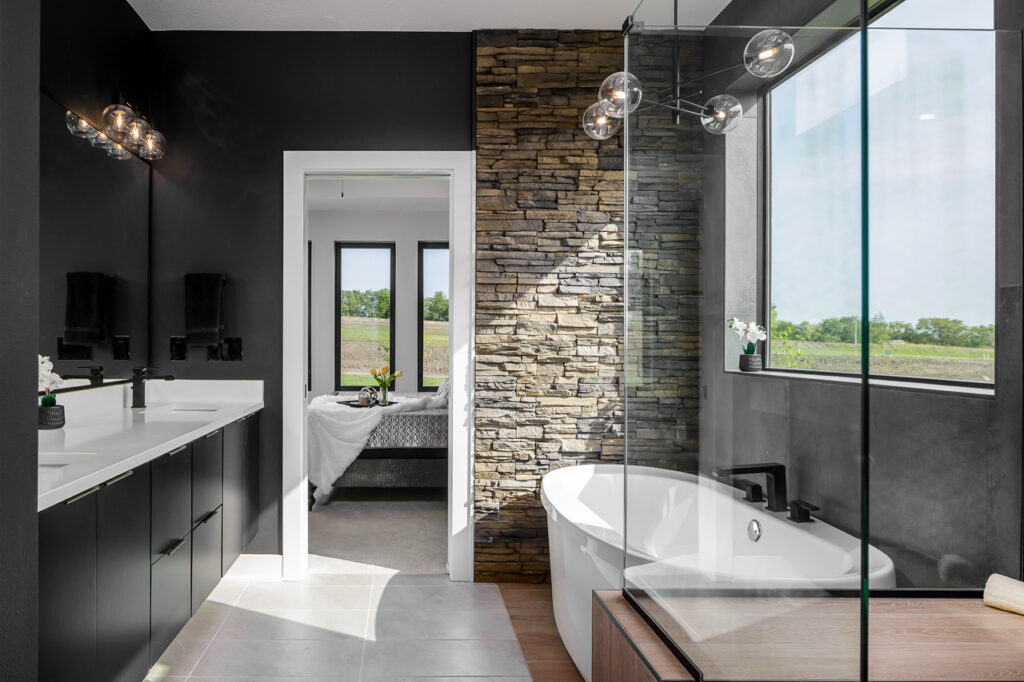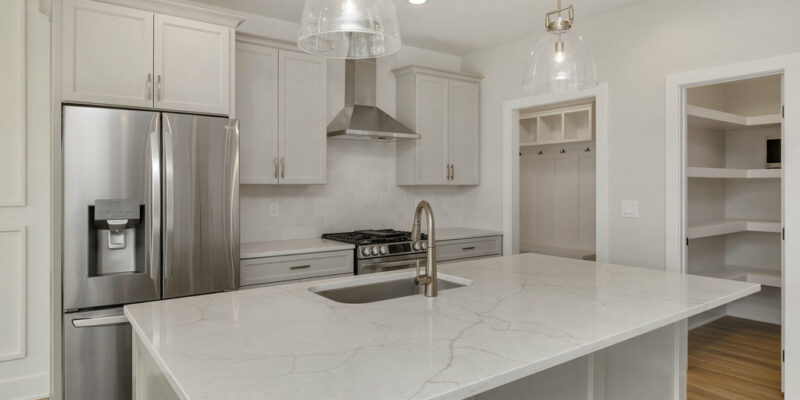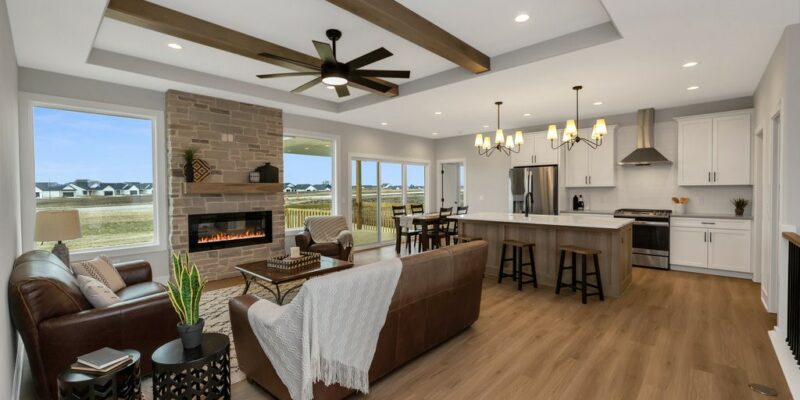Welcome to the wonderful world of soaker tubs! As experts in luxury bathroom design, KRM Custom Homes excitedly introduces you to the latest design trends of 2023. The latest bathroom design trends go beyond aesthetics and add extra focus to innovative features and eco-friendly options.
Soaker tubs embrace these trends while creating a holistic bathing experience. These tubs are the epitome of relaxation and rejuvenation. We’re here to teach you everything you need to know about soaker tubs and help elevate your bathroom experience.
Materials and Finishes: The Perfect Combination
Soaker tubs come in a variety of materials and finishes. Home design trends favor high-quality materials blending style, durability, and comfort. Here are some of the top materials and finishes for soaker tubs in 2023:
Acrylic:
An acrylic soaker tub has a gentle give and softness compared to other materials. Acrylic’s inherent flexibility and lightweight nature provide a cushioned, comfortable bathing experience. Acrylic has fantastic heat retention properties, allowing bathwater to stay warm for long periods.
Their lightweight construction makes installation convenient. Acrylic tubs have a smooth, glossy finish, adding just a touch of elegance to any bathroom. These tubs have a non-porous surface resistant to stains, mold, and mildew. This ensures long-lasting beauty with minimal effort. Acrylic tubs come in a wide range of colors, allowing seamless integration into any design aesthetic.
Cast Iron:
A cast iron bathtub has a distinct feel. It is heavy, dense, and smooth. Cast iron may not feel as warm to the touch as acrylic or fiberglass. However, cast iron retains heat exceptionally well. After filling the tub with warm water, you’re greeted with a cozy and comforting bathing experience. A cast iron tub’s exceptional warmth and substantial feel create a luxurious and indulgent soak.
Cast iron tubs have an enamel finish, adding a layer of protection. This finish gives the tub a glossy, elegant appearance and makes it resistant to stains, scratches, and fading.
Solid Surface:
Solid surface tubs contain natural minerals and resins. The blended result is non-porous and homogeneous. Some solid surface tubs are smooth, while others feel slightly matte or textured. These tubs have a natural warmth that is pleasant to the touch and provides a cozy feeling as you enter the tub. They have good heat retention, allowing you to enjoy your soak fully.
These tubs maintain a consistent temperature. Other materials feel cold, but solid surface tubs feel closer to body temperature, creating a comfortable and inviting sensation.
Copper:
Copper soaker tubs feel cool to the touch. They have an antique charm and come in varying finishes. Some have a polished, reflective surface, while others have a hammered, textured one. Over time, these tubs develop a beautiful patina, adding character to your bathroom.
Copper is a conductive metal, meaning it adjusts quickly to surrounding temperatures. The surface of a copper tub feels cool upon initial contact, but quickly absorbs and retains heat as the tub fills with warm water. Many people appreciate copper tubs for their natural antimicrobial properties. They are inherently resistant to bacterial growth, contributing to a hygienic bathing environment.

Shapes and Sizes: Finding the Perfect Fit
Soaker tubs come in various shapes and sizes. You’ll find the perfect fit for your bathroom, regardless of size! Here are the most popular options for 2023:
Freestanding Tubs:
As the name implies, freestanding tubs do not attach to bathroom walls or other structures. They function anywhere in the bathroom, provided there is proper plumbing and space to accommodate them. This flexibility lets you play with natural light, views, and design preferences. The design and versatility make freestanding tubs a popular option for those seeking a statement piece that combines functionality and aesthetics.
Consider plumbing requirements during the planning and installation process. Freestanding soaker tubs require plumbing connections for filling and draining water. Depending on the design, they may also need floor-mounted faucets or wall-mounted fixtures.
Alcove Tubs:
Alcove tubs, also known as recessed or built-in tubs, fit into a three-wall enclosure or alcove. They are the most common and traditional type of bathtub. Alcove tubs are often rectangular and have a finished front apron. The remaining three sides of the tub sit against the bathroom walls.
Alcove tubs fit neatly into recessed areas. This space-saving design is perfect for smaller bathrooms. They are a practical choice for those who prefer a functional and efficient bathing solution. Their familiar, traditional style suits a range of bathroom designs. They provide support and insulation, creating a comfortable and secure bathing experience. These tubs often have additional features, like built-in shelves, grab bars, or integrated showerheads.
Drop-in Tubs:
Drop-in tub installation involves “dropping” the tub into a pre-existing or custom-built platform so the rim of the tub sits just above it. Installation requires a surrounding structure.
These tubs are highly customizable. They’re easy to integrate into a variety of styles. The tub consists of a basin with no finished sides or front apron. This allows for creative freedom in selecting the surrounding materials. Tile, stone, and other decorative finishes are customizable to match the bathroom aesthetic.
Corner Tubs:
Corner tubs are perfect for making the most of unconventional layouts and limited space. As implied, they fit snugly into corners. They come in unique shapes, such as triangular or curved.
Corner tubs provide a unique focal point in the bathroom and create a sense of openness. Their triangular shape allows ample room for stretching out and enjoying a relaxing soak.

Innovative Features: Enhancing the Soaking Experience
Soaker tubs are no longer just about bathroom aesthetics. Modern soaker tubs contain several luxury features that enhance the bathing experience. These innovative features transform your bathroom into a holistic retreat and create the perfect space for relaxation and self-care. The combination of aesthetics and advanced functionalities provides an experience beyond visual appeal. Some of these features include:
Hydrotherapy Jets:
Hydrotherapy jets provide a soothing experience and promote relaxation. The gentle massaging sensation helps to alleviate muscle tension and reduce stress. Warm water and hydrotherapy jets combine to create a soothing and rejuvenating experience comparable to a spa-like treatment.
Chromatherapy Lighting:
Chromatherapy lighting uses the power of color to enhance your mood and create a calming atmosphere. This feature strategically places colorful LED lights within the tub, creating a serene atmosphere. The subtle hues and gentle transitions of colors enhance relaxation, balance, and well-being.
Heated Backrests:
Heated backrests gently warm the bathtub’s surface, providing an extra layer of comfort. This extra warmth eases muscle stiffness and relieves tension in the neck and back areas. Heated backrests add an extra touch to help users indulge in self-care. The only downside? Leaving your tub feels impossible!
Overflow Drains:
Overflow bathtub drains prevent bathwater from spilling over the tub’s edge. They’re installed near the top edge of the bathtub to allow water drainage, maintaining a constant water level. Additionally, overflow drains create a serene bathing experience. Some overflow drains are designed to allow water to flow continuously over the tub’s edge, creating a tranquil sensory experience.
Eco-Friendly Designs: Sustainable Luxury
It is possible to enjoy a sustainable living area without sacrificing luxury and comfort. Every element of the bathroom provides an opportunity to make eco-conscious choices, and soaker tubs are no exception. As people become aware of their environmental impact, the demand for eco-friendly bathroom designs has grown. Here are some ways to make your soaker tub more sustainable:
Water-Saving Faucets:
Water-saving faucets reduce water consumption without compromising functionality or comfort. They control the water’s flow rate to ensure efficient water usage. Low-flow faucets may include additional water-saving features—like spray options to expand the tub’s versatility, and pause buttons to stop the water flow.
Insulated Tubs:
Insulated tubs retain heat. Minimizing heat loss reduces the energy needed to maintain a pleasant water temperature. Additionally, heat retention helps conserve water by eliminating the need to add more hot water throughout the bath.
Recycled Materials:
Soaker tubs made with reclaimed cast iron and recycled copper reduce environmental impact and add character to any bathroom. Recycled materials minimize the need for new resources while diverting waste from landfills.
Efficient Plumbing:
Efficient bathtub plumbing is crucial when designing an eco-friendly bathroom. Features like flow restrictors, timers, and motion sensors have surprising impacts on minimizing water usage. They conserve water and energy while allowing you to enjoy a soak in a luxury bathroom.
Want to learn more about reducing the environmental impact of your luxury home? Contact us! We’re happy to share our knowledge about innovative features and eco-friendly designs.

Accessorizing Your Soaker Tub: The Finishing Touches
Creating a sensational bathroom experience doesn’t stop at soaker tub installation! While designing a luxury bathroom, consider adding these finishing touches to your soaker tub:
Bath Caddies:
A bath caddy provides a place to stow your favorite book, a glass of wine, or your electronic devices. They offer practical benefits, such as convenience, comfort, and organization. Some caddies hang over the tub’s edge, while others rest across it.
Spa Pillows:
Spa pillows create an ergonomic and comfortable bathing experience. These pillows protect your head and neck while you’re enjoying a soak. They’re made from cushioned, water-resistant materials that offer back and neck support. These qualities allow users to unwind without unnecessary tension.
Aromatherapy:
Essential oils, bath salts, and candles can be used to implement aromatherapy into your bath routine. These additions foster a soothing atmosphere and provide therapeutic benefits. They add ambiance and enhance the sensory aspect of bathtime.
Towel Warmers:
There’s no worse feeling than leaving a warm bath! Towel warmers keep your towels toasty, keeping you comfortable as you exit the tub. Wrapping yourself in a warm and fluffy towel is a truly indulgent experience, and it ends every bath on a positive note.
At KRM Development, we know that every detail counts. The Ask Amanda Series provides more insight into creating the home of your dreams.
Conclusion: Transform Your Bathroom with a Soaker Tub
The latest design trends for soaker tubs in 2023 focus on high-quality materials, innovative features, and eco-friendly designs. These trends transform your space into an eco-friendly oasis. Contact us today, and create the luxury bathroom of your dreams!



